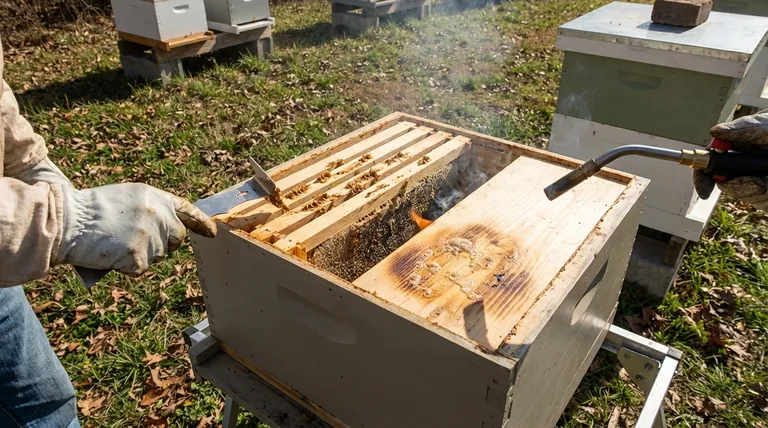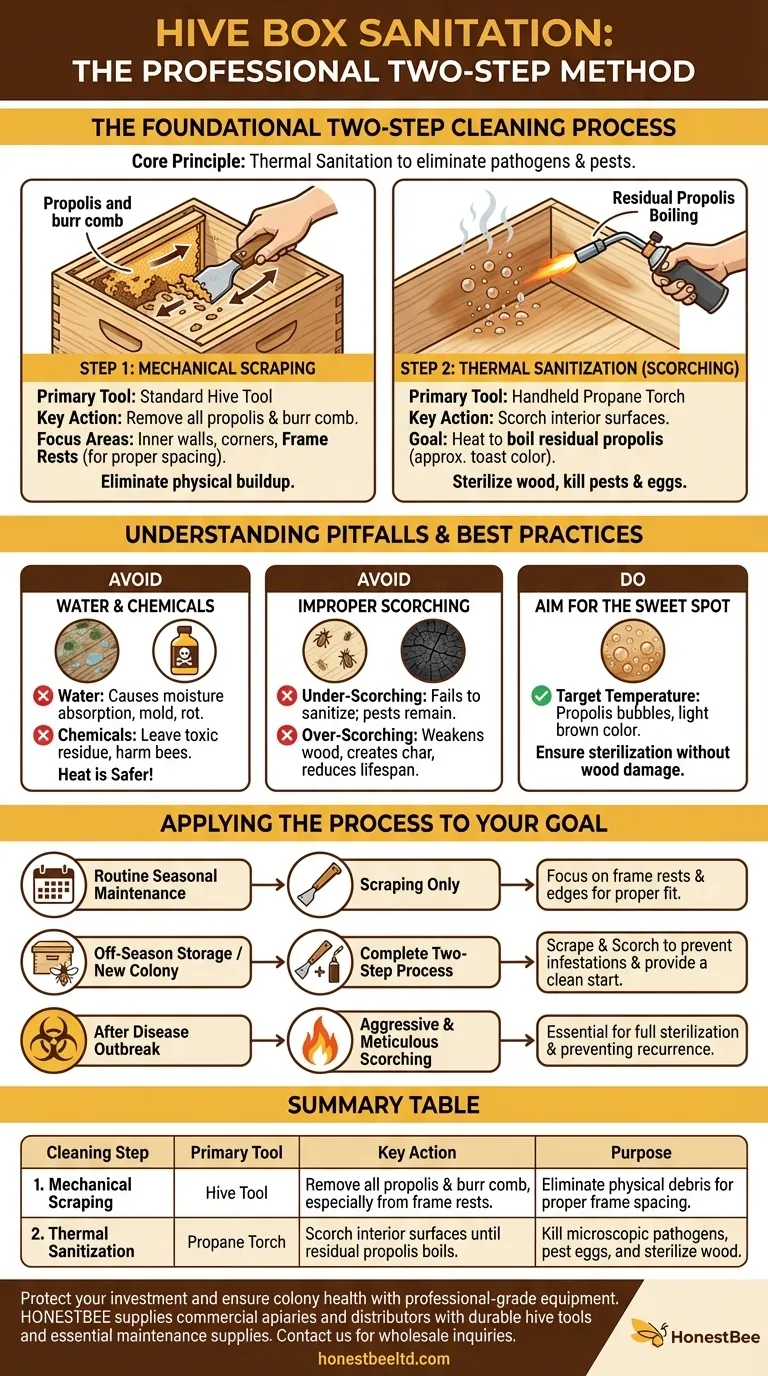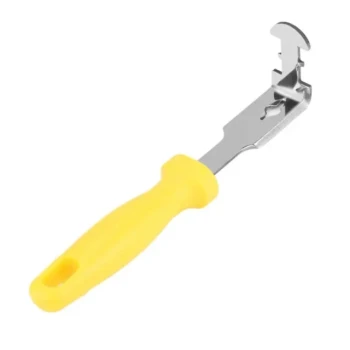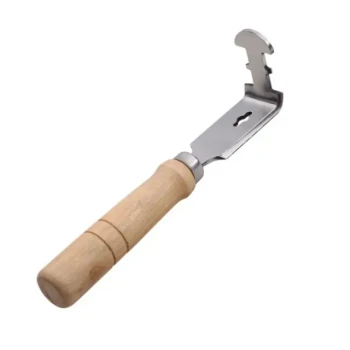The standard professional method for cleaning hive boxes is a two-step process. First, you mechanically scrape away all propolis and burr comb with a hive tool. Second, you sanitize the interior surfaces by carefully scorching them with a handheld propane torch until the residual propolis boils.
The core principle is that cleaning is not just about removing visible debris; it is about thermal sanitation. The goal is to eliminate microscopic pathogens and pest eggs that scraping alone cannot remove, thereby protecting the colony's health and the longevity of your equipment.

The Foundational Two-Step Cleaning Process
To properly clean and sanitize a hive box, you must address both the physical buildup and the unseen biological threats. This method is the industry standard because it avoids chemicals that can harm bees and water that can damage the wood.
Step 1: Mechanical Scraping
The first phase is to remove all physical material from the interior of the box. Your primary tool for this is a standard hive tool.
Focus your efforts on key areas where bees deposit propolis and build burr comb. This includes the inner walls, corners, and especially the frame rests, which are the ledges the frames hang on. Clean frame rests are essential for proper frame spacing and hive inspections.
Step 2: Thermal Sanitization (Scorching)
After scraping, the box may look clean, but it is not yet sanitary. A propane torch is used to sterilize the wood surfaces.
The technique is critical. The goal is not to burn the wood but to heat it just enough to kill pests and pathogens. Move the flame continuously across the interior surfaces, aiming for a light to medium brown color, similar to a piece of toast.
A key indicator of correct temperature is when you see the thin layer of residual propolis begin to bubble and boil. This signifies the surface is hot enough for sterilization without causing significant charring, which can damage the wood's integrity.
Understanding the Pitfalls and Best Practices
While the process is straightforward, improper execution can either be ineffective or damage your equipment. Understanding the reasoning behind each step is crucial.
Why Not Use Water or Chemicals?
Hive boxes are made of wood, which is porous. Using water can lead to moisture absorption, promoting mold, mildew, and wood rot over time.
Chemical cleaners or disinfectants are almost never recommended. Any residue left behind can be toxic to the bees, potentially harming or even killing the entire colony. Heat is a safer and highly effective sterilizing agent.
The Risk of Improper Scorching
There is a fine line between sanitizing and damaging. Under-scorching will fail to eliminate resilient pests or spores, defeating the purpose of the cleaning.
Over-scorching, or creating a deep black char, weakens the wood fibers. This can reduce the lifespan of your hive boxes and make them more susceptible to weather-related damage.
Applying the Process to Your Goal
The intensity and frequency of this deep cleaning depend on the specific situation you are facing with your equipment.
- If your primary focus is routine seasonal maintenance: A thorough scraping of propolis from the frame rests and box edges is often sufficient to ensure components fit together properly.
- If you are preparing boxes for off-season storage or a new colony: The complete two-step process of scraping and scorching is the correct protocol to prevent pest infestation and provide a clean start.
- If you are dealing with equipment after a disease outbreak: Aggressive and meticulous scorching is non-negotiable to fully sterilize the box and prevent any recurrence or spread of the pathogen.
This disciplined approach to hive sanitation is a cornerstone of responsible beekeeping and the long-term health of your colonies.
Summary Table:
| Cleaning Step | Primary Tool | Key Action | Purpose |
|---|---|---|---|
| 1. Mechanical Scraping | Hive Tool | Remove all propolis and burr comb, especially from frame rests. | Eliminate physical debris for proper frame spacing. |
| 2. Thermal Sanitization | Propane Torch | Scorch interior surfaces until residual propolis boils. | Kill microscopic pathogens, pest eggs, and sterilize wood. |
Protect your investment and ensure colony health with professional-grade equipment. Proper hive sanitation is fundamental to successful beekeeping. HONESTBEE supplies commercial apiaries and beekeeping equipment distributors with the durable, high-quality hive tools and other essential supplies needed for effective maintenance. Ensure your operation has the right tools for the job. Contact our wholesale experts today to discuss your needs and keep your colonies thriving.
Visual Guide

Related Products
- HONESTBEE Advanced Ergonomic Stainless Steel Hive Tool for Beekeeping
- Professional Dual-End Stainless Steel Hive Tool for Beekeeping
- Heavy Duty Stainless Steel Frame Cleaner with Plastic Handle
- Professional Stainless Steel Frame Cleaner with Ergonomic Wood Handle
- Professional 3-Bar Frame Grip with Integrated Hive Tool
People Also Ask
- How is a hive tool used for scraping and cleaning? Master Hive Maintenance for a Healthy Colony
- What are the features of a regular hive tool? The Essential Multi-Tool for Every Beekeeper
- What are some common uses of a hive tool? Essential Multi-Purpose Tool for Every Beekeeper
- Why is it important to compare the progress of different hives? A Beekeeper's Key Diagnostic Tool
- What is a hive tool and what are its uses? Master Your Hive Inspections with the Essential Beekeeper's Tool



















